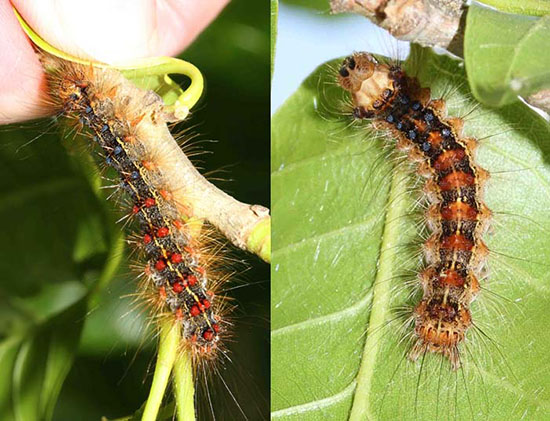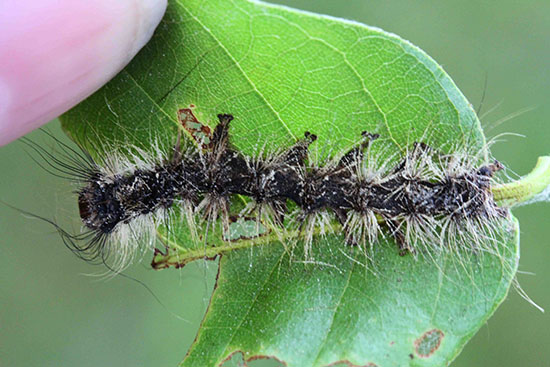Issue 8, June 14, 2016
Gypsy Moth
Gypsy moth larvae are becoming fully grown and migrating to pupation sites. They become very noticeable descending tree trunks, crawling across sidewalks, and crawling on fences and buildings seeking cracks and crevices in which to pupate. This is when many people first notice them, especially if the infestation is too low to cause obvious tree defoliation.
Gypsy moth larvae grow to about two inches long. They are hairy with dorsal double rows of blue balls on the front half of the body. These are followed by dorsal double rows of red balls on the second half of the body. Depending on the individual, these balls vary from being obvious as on the caterpillar on the left to obscure as on the larva on the right.

Gypsy moth larvae color patterns.
Mature larvae form dark brown pupae beneath silk strands under loose tree bark, under building siding, along eaves, and in other cracks and crevices. The adult moths will emerge in about two weeks. Brown male moths have a one and one-half inch wingspan and a black V mark on each front wing. Whitish female moths have a two inch wingspan, and also a black V mark on each front wing.
Male moths are active fliers, being easily seen flying during the daylight hours. Female moths are too heavy-bodied to fly. They mate with males within a few inches of their pupation sites and then lay up to 1000 eggs which they cover with the buff-colored setae from the underside of their abdomens.
Eggs hatch the following spring shortly after oak bud break. The young larvae climb to the tops of trees, spin out silk that catches on the wind, and balloon to new hosts. Larvae feed on leaf margins to the midvein, causing defoliation when present in large numbers.
Successive heavy defoliation for three or more years can kill oaks and other trees growing along streets and in other sites where trees are under stress. Oak, Chestnut, maple, spruce, crabapple, and approximately 200 tree species are attacked. There is one generation per year.
Young larvae are controlled with Bacillus thuringiensis kurstaki, sold as Dipel, Thuricide, and many other trade names. Spinosad, sold as Conserve, and pyrethroid insecticides are also very effective. As larvae get older and larger, they are more difficult to control, making sprays impractical at this time of year.

Gypsy moth cadaver from Entomophage maimaiga.
This is a good time to check for larvae killed by Entomophaga maimaiga, a fungus that commonly provides about 60% control of larvae. Killed larvae will be shriveled and straight with their legs stuck out stiffly to the sides as in the photo. They are sometimes covered with whitish fungal hyphae and spores. Collect these and deposit them on the soil at the base of heavily attacked trees where fungus-attacked larvae are not seen. The spores from these killed larvae will infect descending larvae. The resulting moths will lay infected eggs. (Phil Nixon)
Author:
Phil Nixon